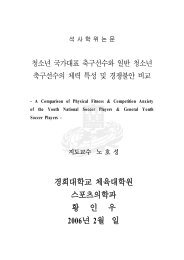경희대학교 동서의학대학원 의 학 영 양 학 과 김 선 아
경희대학교 동서의학대학원 의 학 영 양 학 과 김 선 아
경희대학교 동서의학대학원 의 학 영 양 학 과 김 선 아
Create successful ePaper yourself
Turn your PDF publications into a flip-book with our unique Google optimized e-Paper software.
One of the first modifications to take place is the very critical step of<br />
hydroxylation of selected proline and lysine amino acids in the newly<br />
synthesized procollagen protein (Figure 2). Specific enzymes called<br />
hydroxylases are responsible for these important reactions needed to form<br />
hydroxyproline and hydroxylysine. The hydroxylase enzymes require Vitamin<br />
C and Iron as cofactors.(Mussini E, Hutton JJ, Udenfriend S. 1967) If a<br />
patient is Vitamin C deficient, then this reaction will not occur. In the<br />
absence of hydroxyproline, the collagen chains cannot form a proper helical<br />
structure, and the resultant molecule is weak and quickly<br />
destroyed.(Bienkowski RS, Baum BJ, Crystal RG. 1978) The end result is<br />
poor wound healing, and the clinical condition is called scurvy.(Hirschmann<br />
JV, Raugi GJ. 1999) The current recommended daily allowance for Vitamin<br />
C is 60mg; however, 200mg may be optimal.(Gross RL. 2000; Ayello EA,<br />
Thomas DR, Litchford MA. 1999)<br />
Some of the newly formed hydroxylysine amino acids are glycosylated by<br />
the addition of sugars, such as galactose and glucose.(Anttinen H, Myllyla R,<br />
Kivirikko KI. 1978) The enzymes that catalyze the glycosylation step,<br />
galactosyl and glucosyl transferases, require the trace metal manganese<br />
(Mn 2+ ). The glycosylation step imparts unique chemical and structural<br />
characteristics to the newly formed collagen molecule and may influence<br />
fibril size.(Kivirikko KI, Myllyla R. 1979) It is of interest to note that the<br />
glycosylation enzymes are found with the highest activities in the very<br />
young and decrease as we age.(Anttinen H, Oikarinen A, Kivirikko KI. 1977)<br />
While inside the cell and when the procollagen peptides are intact, the<br />
molecule is about 1,000 times more soluble than it is at a latter stage when<br />
- 20 -

















